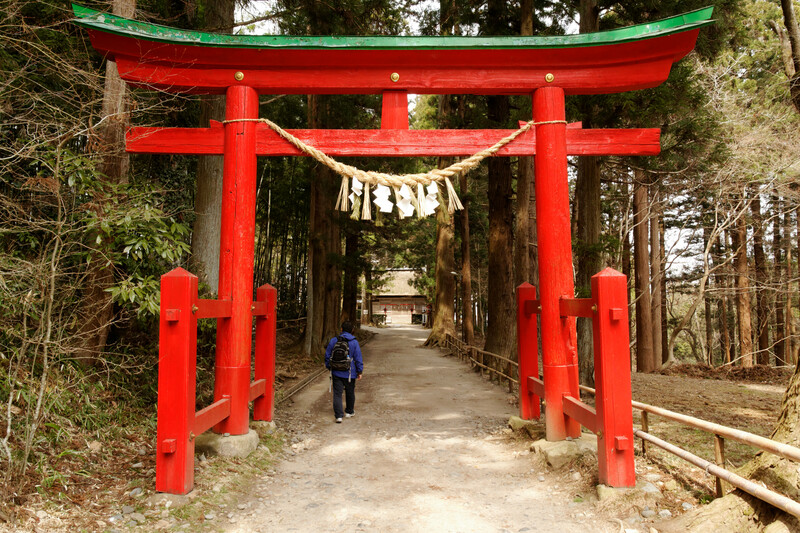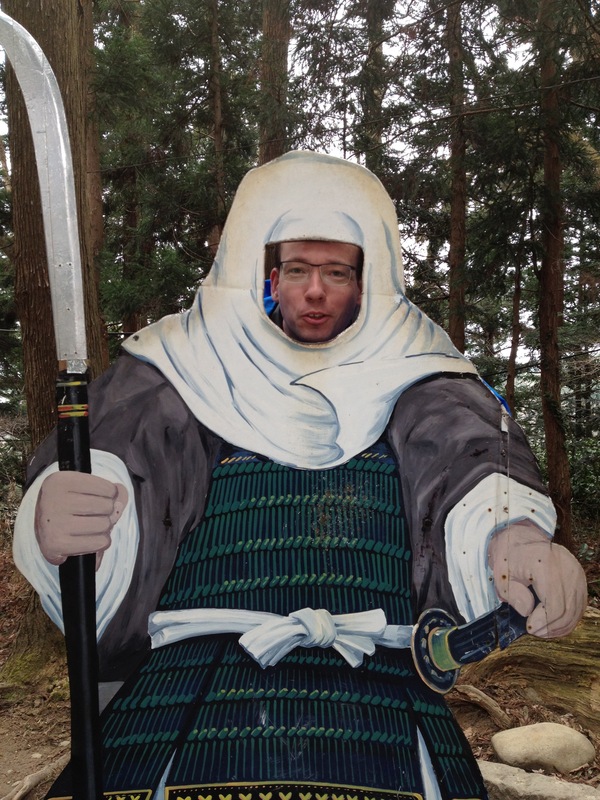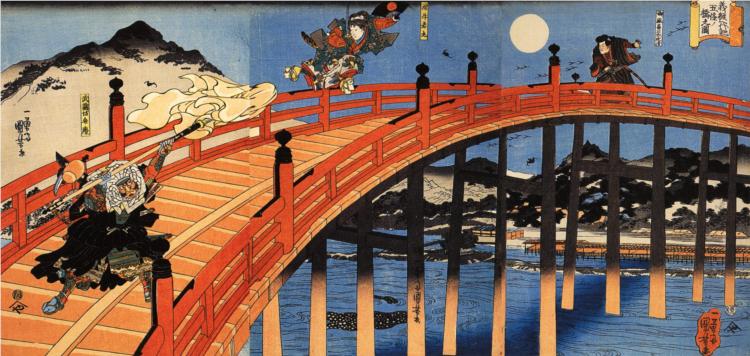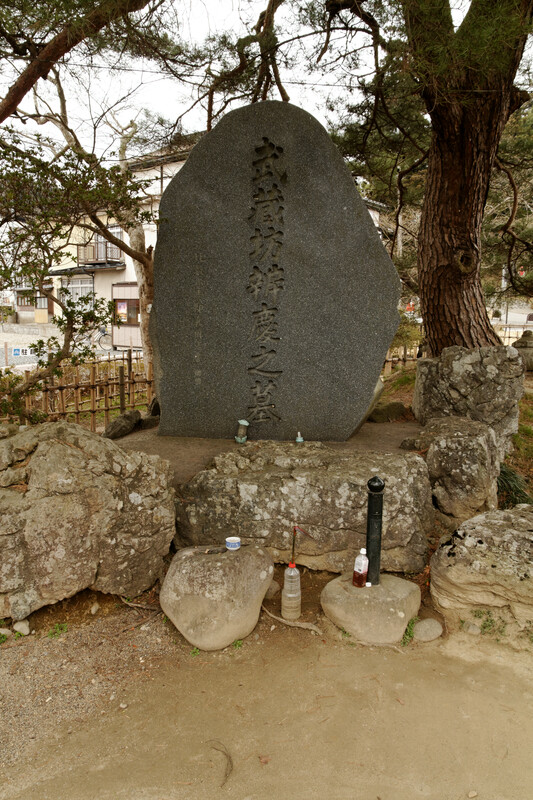History, history everywhere

Gate |
One thing that's struck me about Japan is how amazingly rich their history is, and how you could spend your entire life digging into it, without ever running out of things to learn. That history is still very much alive to the Japanese themselves, and everywhere you turn you are reminded of it.
Once we'd checked into the ryokan in Hiraizumi we headed for the temple hill. On the way we passed a restaurant, which had a poster outside of a samurai carrying a strange curved sword on a long pole. This surprised me, as I thought all samurai used two of the familiar samurai swords. A bit further on was another samurai, also carrying this strange sword. I assumed it was something special for the Tohoku region.

LM posing as Benkei |
Eventually we came to the foot of the hill where the temples are. Here, Naito-san stopped, saying "This is Benkei's grave." Benkei? So he told me the story of Benkei, which turned out to be only a small part of a much larger story. I'll try to explain.
Japan has been ruled by the same imperial family since before the dawn of history. No other country has managed this. Elsewhere, the emperor or king is sooner or later toppled by someone else, from another family, who then sets up his own royal or imperial house. Japan has managed to avoid this because here, when imperial rule was first usurped, the usurpers decided to leave the Emperor on his throne, and instead rule from behind the throne.
Thus, control of the Emperor's person became the symbol signifying that one controlled the empire. In the late 12th century, the Taira (or Heike) clan, ruled Japan. The classic Heike Monogatari (tale of the Heike) tells the story of the Genpei War, in which the Minamoto family won a civil war against the Taira.
In the west, the best-known part is perhaps the Battle of Dannoura, where the Minamoto finally defeated the Heike. At the end of the sea battle, the nurse of the six-year-old Emperor Antoku took him in her arms, and jumped to their deaths in the sea. To this day, fishermen catch strange crabs in these waters, with scowling samurai faces on their shells. The fishermen say the souls of dead samurai live on in the crabs; scientists say it's a classic example of evolution through artificial selection.
Anyway, I was talking of Benkei. Everyone agrees that he was a warrior monk, but the rest of his biography takes many shapes, all of them fanciful. He was clearly an ugly giant of a man, and a great warrior. His chosen weapon was the naginata, the strange, curved sword on a pole, which is something of a symbol for him.
In childhood he was known as Oniwaka (demon/ogre child), and many legends are told of his exploits. Most famously, he took up station on the Gojo Bridge in Kyoto, where he challenged every passing swordsman. Eventually, he collected 999 swords, having defeated every single comer. Opponent number 1000 was Minamoto no Yoshitsune, the great general of the Minamoto clan, who led them to victory in the Genpei War.

The fight between Yoshitsune and Benkei |
Yoshitsune defeated Benkei, who decided that here he had found a master worth following, and Benkei thus became one of Yoshitsune's retainers. They then fought together in the Genpei War. After the war, Yoshitsune, having lead the Minamoto forces, seemed the obvious candidate for the new ruler. Naito-san described him as "a genius of war, but not politics." His brother, Yoritomo, decided he as elder brother should be the ruler, and turned against Yoshitsune. The brother soon got the upper hand, and Yoshitsune retreated to Hiraizumi, and the protection of the Fujiwara clan.
Yoritomo set himself up as the first shogun, the shadow ruler behind the emperor, and established the Minamoto Shogunate, with its capital at Kamakura, beginning the Kamakura Era. Eventually, he turned his attention to his brother, and forced the Fujiwara to attack Yoshitsune near Hiraizumi. When it was clear that the battle was lost, Yoshitsune retreated to commit harakiri, while Benkei fought to keep the enemy off. Eventually, Benkei was killed, though legend has it that he killed 300 enemy warriors first.
He is still revered today for his loyalty to Yoshitsune, and very popular for being a common man with uncommon qualities. Naito-san also says that he's loved because he and Yoshitsune lost. "We Japanese always love the loser," he says. In any case, there are lots of ukiyo-e prints depicting Oniwaka, Benkei, and Yoshitsune, and they feature in many kabuki plays. There's even a Kurosawa movie about them.
And there is the grave, a small stone under a tree, at the foot of the temple hill. A surprisingly small memorial to so big a reputation. But, then, as the famous beginning of the Heike Monogatari has it:
The sound of the Gion Shoja bells echoes the impermanence of all things; the color of the sala flowers reveals the truth that the prosperous must decline. The proud do not endure, they are like a dream on a spring night; the mighty fall at last, they are as dust before the wind.

Benkei's grave |
Similar posts
A short history of the Baltic countries
We don't know much about the history before the advent of writing in the Baltics in the 12th century
Read | 2013-09-15 16:39
Comments
Motomu Naito - 2012-09-19 08:52:16
Great! You studied hard, didn't you? I am really enjoying the Norwegians explanation about Yoshitsune and Benkei.
I want to say one thing about "We Japanese always love the loser." We call it "Hōgan-biiki", sympathy for a tragic hero. Please refer to "In literature" clause in http://en.wikipedia.org/wiki/Minamoto_no_Yoshitsune